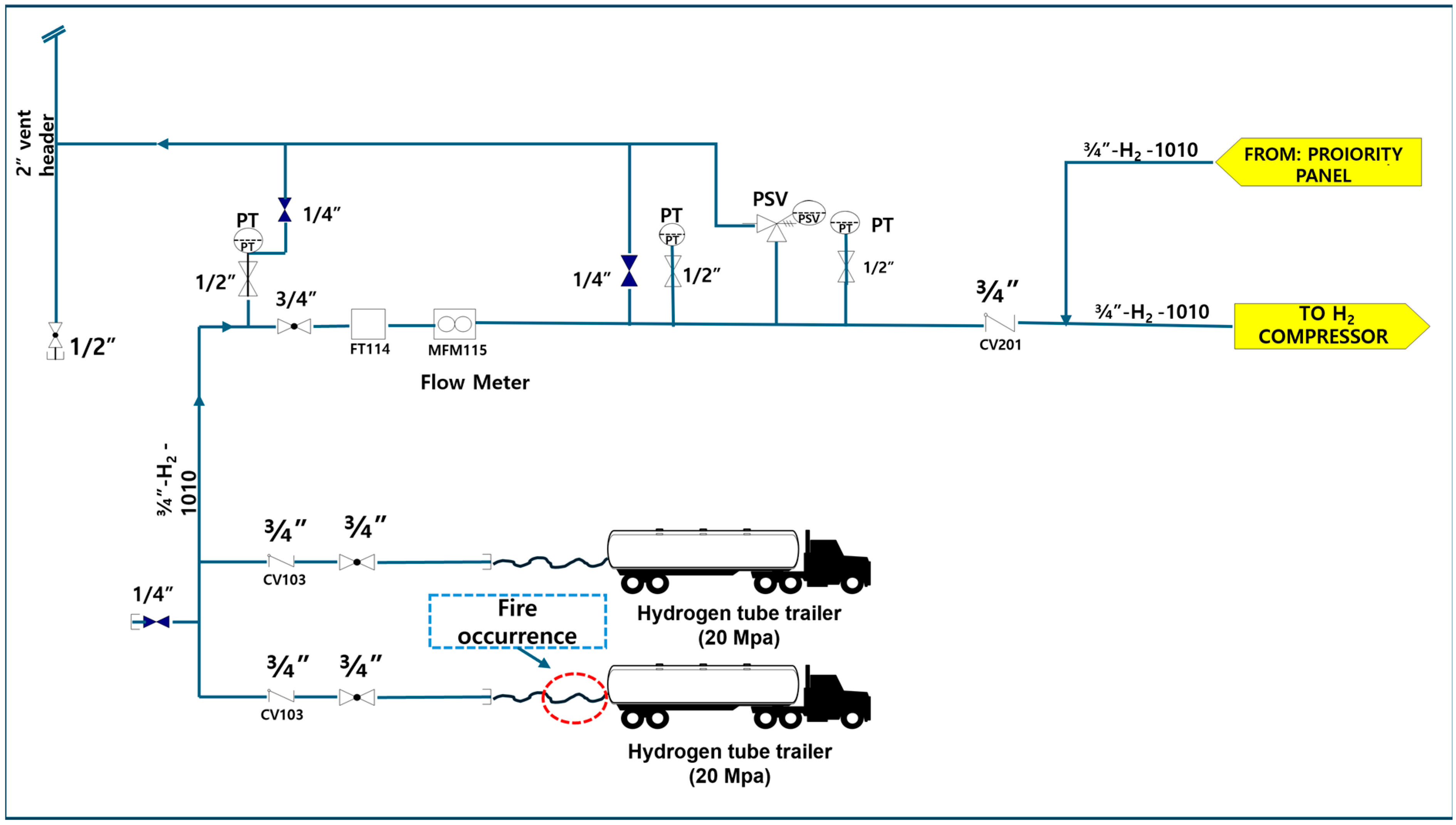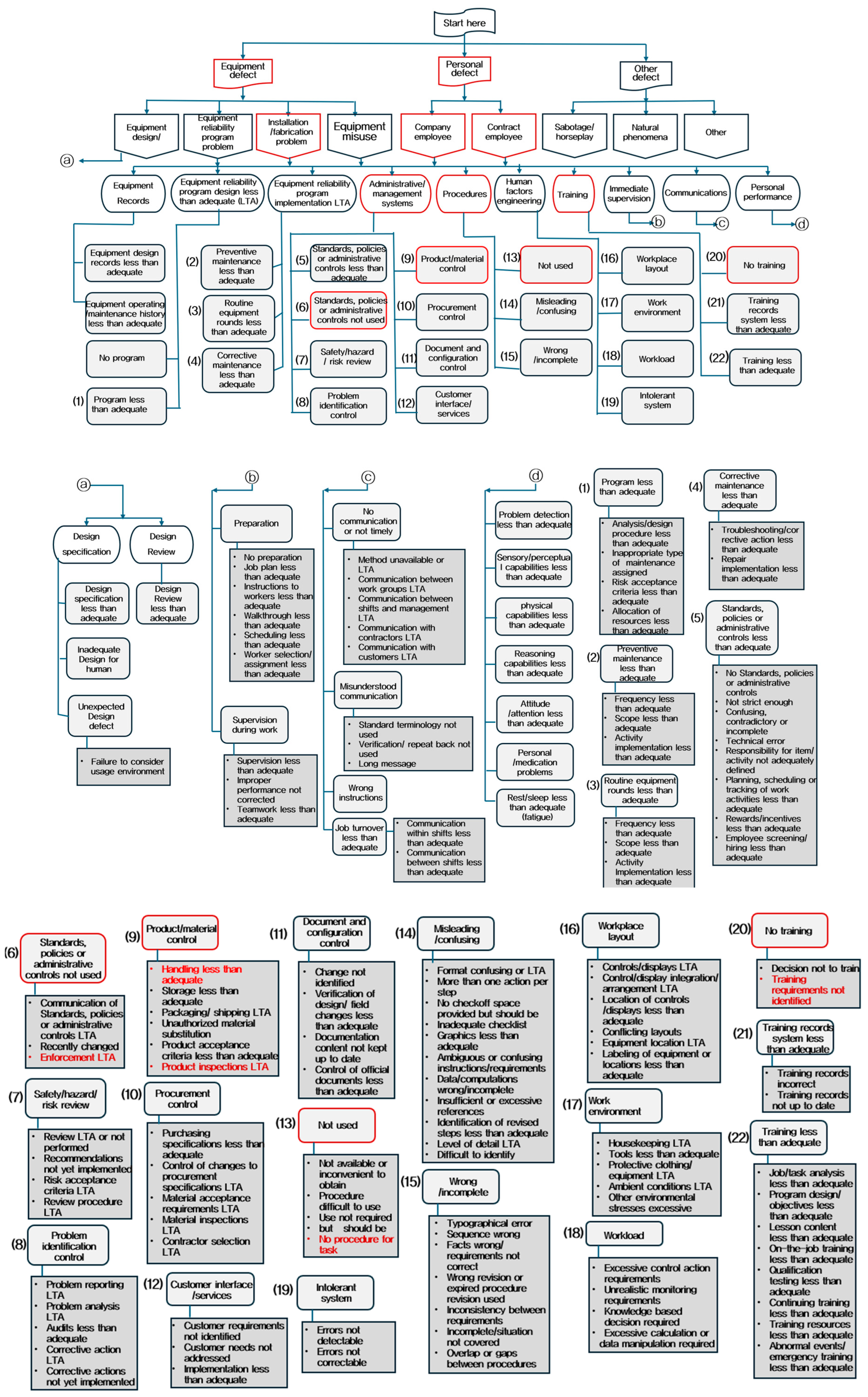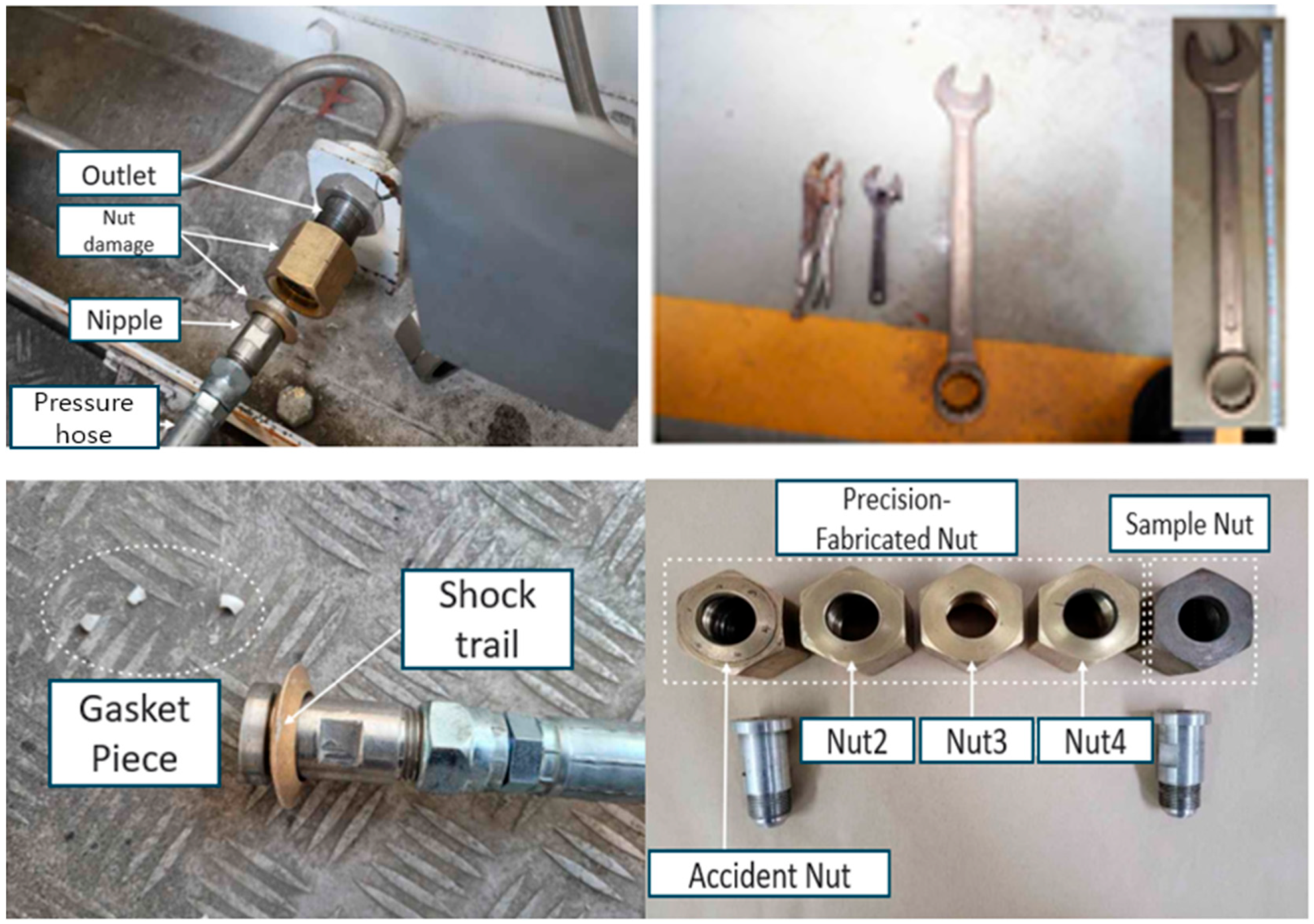Accident Analysis Modeling and Case Study of Hydrogen Refueling Station Using Root Cause Analysis (RCA)
Abstract
1. Introduction
2. Methods
2.1. Analysis Target: Element of Hydrogen Refueling Station
2.2. Development of RCA Model in Hydrogen Refueling Station
2.2.1. RCA Steps
2.2.2. Development and Validation of Hydrogen Refueling Station RCA Modeling Map
3. Results
3.1. Development of Hydrogen Refueling Station RCA Modeling Map
3.2. Hydrogen Refueling Station RCA Modeling Map Verification
3.2.1. Accident Cause Review
- (1)
- Based on CCTV footage from the accident scene, the statements indicated that the fire occurred the moment the container valve was opened after connecting the high-pressure hose. Judging from the worker’s position on CCTV, we presumed that the accident occurred during trailer replacement work.
- (2)
- The hydrogen charging line connection pipe nut in the accident fractured from the boundary between the groove and neck toward the nut neck direction. Based on fracture tests showing similar breakage patterns when tightening nuts with a wrench, and the discovery of deformation and cracks in 4 mm neck thickness nuts during site inspections, we presumed that the nut fractured because the neck thickness was too thin to withstand the tightening force. Additionally, a structural analysis showed that the stress applied to the nut owing to the difference in diameter between the outlet and nipple had less impact compared to the tightening force, suggesting that this was not a major cause of the nut fracture.
- (3)
- We confirmed that the tightening force was transmitted to the connection pipe nut’s neck, stress was concentrated at the boundary between the groove and the connection pipe nut’s neck, and the nut fracture also began at the boundary between the groove and neck.
- (4)
- Given that the color of the nut fracture surface varied in different areas and traces of shifted nipple contact positions were identifiable on the nut and nipple contact surface, we presumed that the connection pipe nut’s fracture occurred as deformation increased and cracks grew during repeated tightening processes.
- (5)
- While various factors such as friction heat, sparks, and static electricity could serve as ignition sources during high-pressure hydrogen discharge, the specific cause of ignition could not be determined.
- (6)
- The cause of manufacturing the 4 mm neck thickness nut could not be confirmed because statements from the connection pipe nut in accident manufacturer and the contractor did not match.
3.2.2. Cause of Accident
- (1)
- Nuts that were too thin could fracture as they could not withstand the tightening force. However, site inspections revealed that nuts were not standardized, with different thicknesses installed at different refueling stations.
- (2)
- There was a risk of nut deformation and fracture if workers tightened nuts with excessive force.
- (3)
- Without an emergency shutdown device installed on the tube trailer, there was a possibility of the incident developing into a major accident.
3.2.3. Application of RCA Modeling Map
Causal Factor Charting Analysis
Root Cause Identification
- (1)
- The nuts of high-pressure hoses connecting hydrogen tube trailers to refueling stations were not legally standardized. Upon checking the nut specifications of high-pressure hoses installed at 90 hydrogen refueling stations nationwide, 19 stations had nuts with neck thicknesses of 4–8 mm, while 71 stations had nuts installed with thicknesses over 8 mm. Considering this, the lack of legal standardization for the nut neck thickness of high-pressure hose has resulted in different nut neck thicknesses being used at different stations.
- (2)
- The quality control system for purchases at piping construction company A was inadequate or non-functional. The piping construction company claimed that they received sample nuts with a neck thickness of 10 mm from the hydrogen tube trailer supplier for connecting to the tube trailer’s high-pressure hose, and requested precision machinery manufacturing company A to manufacture one with the same specifications. However, the precision machine manufacturing company A claimed that they received nuts with a neck thickness of 4 mm from piping construction company B and manufactured and delivered them according to those specifications. Given these conflicting claims between the two parties, there were evidently issues with the quality management system, such as piping construction company B’s failure to properly manage the product purchase process.
- (3)
- Precision machinery manufacturing company A’s quality control of raw materials and manufactured products was insufficient. Given that both parties’ claims about nut specifications differed after the accident, indicating that the precision machinery company failed to properly verify desired specifications when receiving the manufacturing order from the piping construction company, there were clearly problems with precision machinery manufacturing company A’s quality management system.
- (4)
- Hydrogen refueling station A and hydrogen tube trailer operators lacked standards or work procedures for connecting high-pressure hoses. When connecting high-pressure hose nuts to hydrogen tube trailers for hydrogen delivery to a hydrogen refueling station, tube trailer operators disregarded safety by arbitrarily purchasing and using non-explosion spanner tools and not using torque wrenches, indicating a lack of established standards or work procedures for hose connection work.
- (5)
- Hydrogen safety and safety work training was insufficient. Given that non-explosion tools were used and torque wrenches were not employed when handling hydrogen (i.e., a high-pressure flammable gas), we determined that safety training for hydrogen tube trailer operators and refueling station workers regarding hydrogen safety and safe work practices was inadequate.
- (6)
- Legal regulations for installing emergency shutdown devices on hydrogen tube trailers were not in place. While emergency shutdown devices should be installed to quickly shut off hydrogen gas in case of gas leaks or fire risks during loading and unloading operations for tube trailers, currently only manual operation valves are attached to hydrogen tube trailers. With manual operation valves, depending on the situation during an accident, access to the valve might be difficult, potentially preventing quick shutdown and leading to accident escalation.
- (1)
- Failure to verify the difference between the requested nut specifications and the manufactured and delivered nut product specifications. Both piping construction company A, which ordered the nuts, and precision machinery manufacturing company A, which manufactured and delivered them, overlooked the verification of nut specification accuracy during the ordering and product delivery processes.
- (2)
- Failure to verify different nut product specifications during piping construction at the hydrogen refueling station. During piping construction, there was a failure to reconfirm and construct according to the specifications for the relevant nuts.
- (3)
- Work was performed without using a torque wrench when connecting high-pressure hydrogen hose nuts to the hydrogen tube trailer. While a torque wrench should have been used to perform torque work according to the set torque for each nut specification during nut connection work, the nuts were damaged due to excessive tightening using regular spanner tools instead of torque wrenches.
4. Discussion
5. Conclusions
Author Contributions
Funding
Institutional Review Board Statement
Informed Consent Statement
Data Availability Statement
Conflicts of Interest
References
- European Commission. Communication from the Commission—The European Green Deal. (COM(2019) 640 Final). Available online: https://eur-lex.europa.eu/legal-content/EN/TXT/?uri=celex%3A52019DC0640 (accessed on 19 June 2024).
- The 2050 Carbon Neutrality and Green Growth Commission. Available online: http://www.2050cnc.go.kr (accessed on 19 June 2024).
- Korea Gas Safety Corporation. Gas Information Management System (GIMS); Korea Gas Safety Corporation: Seongnam, Republic of Korea, 2021. [Google Scholar]
- Yang, F.; Wang, T.; Deng, X.; Dang, J.; Huang, Z.; Hu, S.; Li, Y.; Ouyang, M. Review on hydrogen safety issues: Incident statistics, hydrogen diffusion, and detonation process. Int. J. Hydrogen Energy 2021, 46, 31467–31488. [Google Scholar] [CrossRef]
- Korea Gas Safety Corporation. Gas Accident Almanac; Korea Gas Safety Corporation: Seongnam, Republic of Korea, 2021. [Google Scholar]
- Park, B.; Kim, Y.; Lee, K.; Paik, S.; Kang, C. Risk assessment method combining independent protection layers (IPL) of layer of protection analysis (LOPA) and RISKCURVES software: Case study of hydrogen refueling stations in urban areas. Energies 2021, 14, 4043. [Google Scholar] [CrossRef]
- Kikukawa, S.; Mitsuhashi, H.; Miyake, A. Risk assessment for liquid hydrogen fueling stations. Int. J. Hydrogen Energy 2009, 34, 1135–1141. [Google Scholar] [CrossRef]
- Suzuki, T.; Shiota, K.; Izato, Y.; Komori, M.; Sato, K.; Takai, Y.; Ninomiya, T.; Miyake, A. Quantitative risk assessment using a Japanese hydrogen refueling station model. Int. J. Hydrogen Energy 2021, 46, 8329–8343. [Google Scholar] [CrossRef]
- Patel, P.; Garaniya, V.; Baalisampang, T.; Arzaghi, E.; Abbassi, R.; Salehi, F. A technical review on quantitative risk analysis for hydrogen infrastructure. J. Loss Prev. Process Ind. 2024, 91, 105403. [Google Scholar] [CrossRef]
- Kwon, D.; Choi, S.K.; Yu, C. Improved safety by cross-analyzing quantitative risk assessment of hydrogen refueling stations. Int. J. Hydrogen Energy 2022, 47, 10788–10798. [Google Scholar] [CrossRef]
- Zhang, J.; Zhang, S.; Liang, Z.; Lang, X.; Shi, M.; Qiao, J.; Wei, J.; Dai, H.; Kang, J. A risk assessment method based on DEMATEL-STPA and its application in safety risk evaluation of hydrogen refueling stations. Int. J. Hydrogen Energy 2024, 50 Pt A, 889–902. [Google Scholar] [CrossRef]
- Wang, X.; Gao, W. Hydrogen leakage risk assessment for hydrogen refueling stations. Int. J. Hydrogen Energy 2023, 48, 35795–35808. [Google Scholar] [CrossRef]
- Delikhoon, M.; Zarei, E.; Valdez Banda, O.; Faridan, M.; Habibi, E. Systems thinking accident analysis models: A systematic review for sustainable safety management. Sustainability 2022, 14, 5869. [Google Scholar] [CrossRef]
- Khodadadi-Mousiri, A.; Yaghoot-Nezhad, A.; Sadeghi-Yarandi, M.; Soltanzadeh, A. Consequence modeling and root cause analysis (RCA) of the real explosion of a methane pressure vessel in a gas refinery. Heliyon 2023, 9, e14628. [Google Scholar] [CrossRef] [PubMed]
- Arias Velásquez, R.M.; Mejía Lara, J.V. Converting data into knowledge with RCA methodology improved for inverters fault analysis. Heliyon 2022, 8, e10094. [Google Scholar] [CrossRef] [PubMed]
- Sapre, S.; Vyas, M.; Pareek, K. Impact of refueling parameters on storage density of compressed hydrogen storage tank. Int. J. Hydrogen Energy 2021, 46, 16685–16692. [Google Scholar] [CrossRef]
- Korea Gas Safety Corporation. Hydrogen Refueling Station’s Technical Data; Korea Gas Safety Corporation: Seongnam, Republic of Korea, 2021. [Google Scholar]
- Vanden Heuvel, L.N.; Lorenzo, D.K.; Jackson, L.O. Root Cause Analysis Handbook: A Guide to Efficient and Effective Incident Management, 3rd ed.; Rothstein Publishing: Brookfield, WI, USA, 2008; pp. 1–300. [Google Scholar]
- Hosseinzadeh, A.; Zhou, J.L.; Li, X.; Afsari, M.; Altaee, A. Techno-economic and environmental impact assessment of hydrogen production processes using bio-waste as renewable energy resource. Renew. Sustain. Energy Rev. 2022, 156, 111991. [Google Scholar] [CrossRef]
- Jayakumar, A.; Madheswaran, D.K.; Kannan, A.M.; Sureshvaran, U.; Sathish, J. Can hydrogen be the sustainable fuel for mobility in India in the global context? Int. J. Hydrogen Energy 2022, 47, 33571–33596. [Google Scholar] [CrossRef]
- Kindra, V.; Maksimov, I.; Oparin, M.; Zlyvko, O.; Rogalev, A. Hydrogen technologies: A critical review and feasibility study. Energies 2023, 16, 5482. [Google Scholar] [CrossRef]
- Lee, J.-Y.; Yoo, M.; Cha, K.; Lim, T.W.; Hur, T. Life cycle cost analysis to examine the economical feasibility of hydrogen as an alternative fuel. Int. J. Hydrogen Energy 2009, 34, 4243–4255. [Google Scholar] [CrossRef]
- Riera, J.A.; Lima, R.M.; Knio, O.M. A review of hydrogen production and supply chain modeling and optimization. Int. J. Hydrogen Energy 2023, 48, 13731–13755. [Google Scholar] [CrossRef]
- Erdoğan, A.; Geçici, E.; Güler, M.G. Design of a future hydrogen supply chain: A multi-objective model for Turkey. Int. J. Hydrogen Energy 2023, 48, 11775–11789. [Google Scholar] [CrossRef]
- Erdoğan, A.; Güler, M.G. Optimization and analysis of a hydrogen supply chain in terms of cost, CO2 emissions, and risk: The case of Turkey. Int. J. Hydrogen Energy 2023, 48, 22752–22765. [Google Scholar] [CrossRef]







| No. | Contents | Shape | Elements |
|---|---|---|---|
| 1 | Hydrogen tube trailer supplier provides 10 mm neck-thick sample nuts to piping construction company (‘21.11) | □ | Event |
| 2 | Piping construction company provides one 10 mm sample nut to the precision machinery company and requests the production of the same product (‘21.11) | □ | Event |
| 3 | Manufacturing nuts by precision machinery company and delivering them to piping construction company (‘21.11) | □ | Event |
| 4 | When the piping construction company constructs the hydrogen refueling station where the accident occurred, it is constructed using one nut supplied by a precision machinery company (‘21.11) | □ | Event |
| 5 | High-pressure hose of the hydrogen chargingstation is fastened to the hydrogen tube trailer for hydrogen introduction into the hydrogen refueling station (‘22.01.28) | □ | Event |
| 6 | After opening the inlet valve of the hydrogen refueling station, gas leakage and fire occur upon opening the container manual valve of the tube trailer. (2 people injured in fire.) (‘22.01.28) | ◊ | Accident |
| 7 | To be used as a connector nut for a high-pressure connection pipe to receive hydrogen from a hydrogen tube trailer to a hydrogen refueling station | ○ | Condition |
| 8 | Specifications of the high-pressure hose connecting to the tube trailer vary from station to station | ○ | Condition |
| 9 | High-pressure hose nut connecting to tube trailer is not legally standardized | ⬡ | Cause factor (root cause) |
| 10 | The precision machine company does not confirm that the sample nut requested to be manufactured by the piping construction company is suitable for the required specification | ○ | Condition |
| 11 | Failure to confirm that the requested nut specification and the delivered nut specification are different | ○ | Condition |
| 12 | Insufficient quality management system of the precision machine company | ⬡ | Cause factor (root cause) |
| 13 | The piping construction company does not conduct quality inspection on nuts supplied by the precision machine company | ○ | Condition |
| 14 | Failure to confirm that the requested nut specification and the delivered nut specification are different | ○ | Condition |
| 15 | Insufficient quality management system of the piping construction company | ⬡ | Cause factor (root cause) |
| 16 | The statement of the precision machinery company that manufactured the nuts and the piping construction company that received the nuts did not match, so it was impossible to confirm the 10 mm nuts’ delivery | ○ | Condition |
| 17 | As a result of the investigation, we confirmed that all nuts supplied by the precision machinery company to three other stations were approximately 4 mm thick, and all of them were cracked | ○ | Condition |
| 18 | During the construction of piping at the charging station, we did not confirm that the nut was a 10 mm product | ○ | Condition |
| 19 | No torque wrench was used when nutting the high-pressure hose to the tube trailer (engaged using a regular spanner) | ○ | Condition |
| 20 | The tools required for fastening work are purchased and used by tube trailer drivers, so safety such as explosion proof tools is not considered | ○ | Condition |
| 21 | No standards or procedures for fastening high-pressure hoses | ⬡ | Cause factor (root cause) |
| 22 | Workers lack awareness of the use of explosion-proof tools and work safety to prevent hydrogen explosion | ○ | Condition |
| 23 | Insufficient hydrogen safety and safety work training | ⬡ | Cause factor (root cause) |
| 24 | Ignition source was not confirmed | ○ | Condition |
| 25 | Locked using a manual valve attached to the tube trailer when gas leaks or fires occur due to nut breakage | ○ | Condition |
| 26 | The hydrogen tube trailer does not have an emergency shut-off valve | ○ | Condition |
| 27 | No legal regulations for installing emergency shut-off valves on hydrogen tube trailer | ⬡ | Cause factor (root cause) |
| 28 | In the event of a gas leak or fire, inaccessible for manual valve use depending on the situation | ○ | Condition |
Disclaimer/Publisher’s Note: The statements, opinions and data contained in all publications are solely those of the individual author(s) and contributor(s) and not of MDPI and/or the editor(s). MDPI and/or the editor(s) disclaim responsibility for any injury to people or property resulting from any ideas, methods, instructions or products referred to in the content. |
© 2025 by the authors. Licensee MDPI, Basel, Switzerland. This article is an open access article distributed under the terms and conditions of the Creative Commons Attribution (CC BY) license (https://creativecommons.org/licenses/by/4.0/).
Share and Cite
Lee, I.J.; Lee, A.R.; Lee, K.-S. Accident Analysis Modeling and Case Study of Hydrogen Refueling Station Using Root Cause Analysis (RCA). Safety 2025, 11, 60. https://doi.org/10.3390/safety11020060
Lee IJ, Lee AR, Lee K-S. Accident Analysis Modeling and Case Study of Hydrogen Refueling Station Using Root Cause Analysis (RCA). Safety. 2025; 11(2):60. https://doi.org/10.3390/safety11020060
Chicago/Turabian StyleLee, Il Jae, A Ran Lee, and Kyung-Sun Lee. 2025. "Accident Analysis Modeling and Case Study of Hydrogen Refueling Station Using Root Cause Analysis (RCA)" Safety 11, no. 2: 60. https://doi.org/10.3390/safety11020060
APA StyleLee, I. J., Lee, A. R., & Lee, K.-S. (2025). Accident Analysis Modeling and Case Study of Hydrogen Refueling Station Using Root Cause Analysis (RCA). Safety, 11(2), 60. https://doi.org/10.3390/safety11020060





